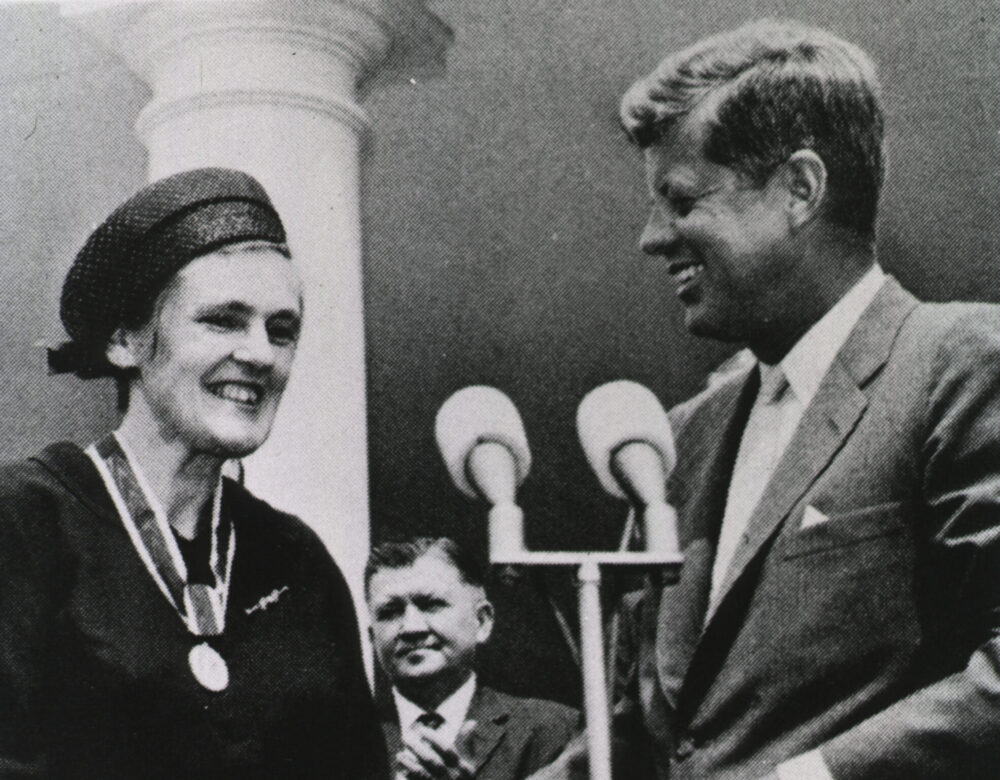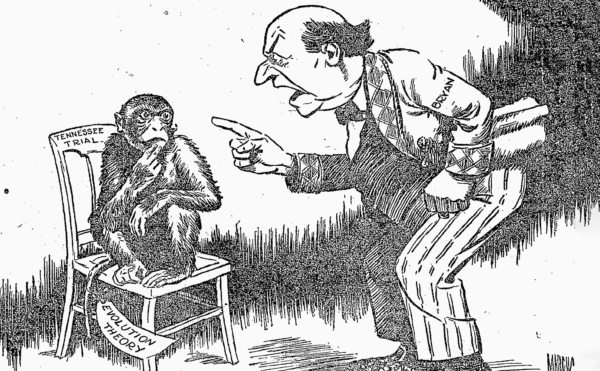Frances Oldham Kelsey received a medal from President John F. Kennedy and once appeared on a list of the most admired women in the world. Virtually unknown now, she was an FDA scientist who stood up to a bullying pharmaceutical company. Her method? Blocking the approval of a drug called thalidomide that was so infamous it ended up in a Billy Joel song and a poem by Sylvia Plath. The move spared thousands of American babies from terrible birth defects, so why is her legacy so complicated?
About The Disappearing Spoon
Hosted by New York Times best-selling author Sam Kean, The Disappearing Spoon tells little-known stories from our scientific past—from the shocking way the smallpox vaccine was transported around the world to why we don’t have a birth control pill for men. These topsy-turvy science tales, some of which have never made it into history books, are surprisingly powerful and insightful.
Credits
Host: Sam Kean
Senior Producer: Mariel Carr
Producer: Rigoberto Hernandez
Associate Producer: Sarah Kaplan
Audio Engineer: Rowhome Productions
Transcript
In the mid-1960s, the artist Una Hanbury sculpted two statues of famous female scientists. One depicted Rachel Carson, the environmentalist who wrote Silent Spring. Given Carson’s iconic status, that bust ended up in the U.S. National Portrait Gallery.
The other bust depicted a woman who was every bit as revered at the time. A woman who received a medal from President John F. Kennedy, and who once appeared on a list of the most admired women in the world, alongside Marie Curie, Queen Elizabeth, and Hellen Keller. Her name was Frances Oldham Kelsey.
Now, if you’re asking yourself, “Who is Frances Oldham Kelsey?,” you’re not alone. She’s hardly famous anymore. And unlike Rachel Carson’s statue, the bust of Kelsey never found its way into a museum. It now sits in her daughter’s living room, collecting dust.
As a scientist, Kelsey wasn’t known for groundbreaking discoveries, but for an act of moral courage. She worked at the FDA. And in 1960, she fought against the approval of a certain drug. A drug that grew so notorious that Sylvia Plath wrote a poem about it. It also got mentioned in the Billy Joel song, “We Didn’t Start the Fire,” right alongside Mickey Mantle, Jack Kerouac, and Sputnik.
“Lebanon, Charles de Gaulle, California baseball.
Starkweather homicide, children of thalidomide.”
Thalidomide was a sedative used to fight morning sickness in pregnant women. But scientists later discovered that it caused shocking birth defects in babies. And Kelsey’s fight against it would forever change how we view drugs—partly for the better, partly for worse.
Growing up, Frances Oldham Kelsey was called a “tomboy”—“all piss and vinegar,” as one biographer said. She loved hunting and fishing around her home on Vancouver Island in Canada. She had short, dark, wavy hair with her chin thrust forward and smoldering brown eyes.
Once, while playing catch with a friend in grade school, their ball smashed a church window. The girls ran away before being caught. But when the priest mentioned the broken window that Sunday during services, Kelsey stood up, marched up to the pulpit, and announced to the whole congregation that she’d done it. She was never shy about standing up and taking responsibility.
She entered college at age 16 in Montreal, studying biochemistry and pharmacology. After college, she applied for graduate school.
But she struggled to gain admission anywhere, largely because she was a woman. The male scientists who ran labs then often disdained women’s abilities. Some also voiced fears that women would just get pregnant and quit halfway through a project. These were not uncommon sentiments then.
But Kelsey caught a break. She mailed an application to a South African biochemist at the University of Chicago. He normally didn’t hire women. But he also didn’t know the difference between the male and female spellings of the name “Frances.” So, sight unseen, he hired her.
And to be fair, that biochemist later admitted he was wrong about women. He became Kelsey’s mentor and champion, and she repaid his faith.
Kelsey’s mother was terrified about her daughter moving to 1930s Chicago. Wasn’t the city full of gangsters? It was, but Kelsey loved the hustle and bustle. And she thrived in the lab.
One research project of hers involved analyzing an antibiotic drink that killed dozens of children. Turns out, the manufacturer was mixing antifreeze in. It’s a dark tale. I’ve actually made a bonus episode about it if you’d like to hear more. Visit patreon.com/disappearingspoon.
After earning her Ph.D., Kelsey stayed on at U-Chicago and worked on antimalarial drugs during World War II. She tested them on rabbits. And at one point, she noticed something funny. That infant rabbits couldn’t metabolize the drugs. The drugs built up to dangerous levels inside them.
She concluded from this that adults and infants handled drugs differently. Infant organs simply couldn’t break certain drugs down very well. Nowadays, doctors know this fact well. But at the time, it was a novel finding.
While working on the malaria drugs, Kelsey met a man named Ellis who soon became her husband. Unfortunately, U-Chicago had anti-nepotism rules. No married couples could work in the same lab. After talking things over, they decided one of them should attend medical school, since doctors had an easier time finding jobs. As Kelsey later recalled, they flipped a coin, and she lost. So, off to med school.
During med school, she gave birth to two daughters, but still graduated on time. Afterward, Ellis took a job at the University of South Dakota, and Frances and family followed. She practiced medicine part-time there, tending rattlesnake bites and hunting accidents on the prairie.
To keep her lab skills sharp, she kept doing research, too, on the glands of animals. One day, she trapped several beavers and put them in her office overnight. She returned the next morning to find all the legs gnawed off her furniture.
The Kelsey’s left South Dakota in 1960. At this point Frances took a job at the FDA in Washington D.C.—in part, she joked, because the agency paid her family’s moving expenses.
She arrived to find the FDA embroiled in scandals. A regulator had been caught taking bribes recently. Aso, pharmaceutical scientists were reportedly faking data on cholesterol drugs.
But the real scandal was what was legal. Drug company reps could just waltz right into the FDA building and schmooze with regulators, charming them into approving drugs. And if that didn’t work, they would bully and harass them.
Not that the drug reps normally had to work that hard. At the time, FDA regulators had sixty days to approve or reject a new drug. And if they didn’t do anything, the drug automatically became legal. The whole approval process was a joke.
Kesley joined FDA to review applications for new drugs. But as a trained scientist, an MD-Ph.D., she was shocked at how shoddy most applications were.
Instead of providing safety data or efficacy data, companies often just supplied testimonials from doctors who gave the drugs to their patients. Testimonials like, Boy, this drug works great! Or, I’d give it to my own children! Not exactly rigorous science. Plus, many doctors didn’t even bother asking questions about side effects.
Kelsey didn’t stand for that. On her applications, she demanded data. In response, the drug companies howled and moaned. One company sued the FDA after she rejected a drug. Another denounced her as “un-American.”
Thalidomide came across Kelsey’s desk in September 1960. It was a German drug, a sleeping pill and anti-nausea medication. Most countries in Europe had already approved it. They did so despite the big red flag that several of the company’s executives were former Nazis. A few had worked in extermination camps.
But people didn’t seem to care, and the drug proved quite popular. Executives promised it was so safe that parents could knock their children out with it and head to the movies with no worries. Ah, the ‘60s.
A company named Merrell Pharmaceuticals licensed the drug to sell in the United States market. And they were in a hurry. They wanted the drug approved before December, since sedative use often spiked around the holidays.
Even before submitting an FDA application, Merrell stocked its warehouses with 10 million thalidomide tablets, ready to push, push, push the pill to doctors. They just needed Kelsey to rubber-stamp her approval, and they could cash in.
Except, Kesley hesitated. The application included zero data, and nothing about side effects. The biggest red flag involved an animal test. The company’s scientists had force-fed the sleeping pills to some horses. But no matter how much the scientists fed them, they couldn’t knock the horses out. The horses simply wouldn’t metabolize it.
Kelsey immediately thought back to her research on rabbits and malaria drugs. Those drugs built up to dangerous levels inside infants for the same reason: the infants’ bodies couldn’t metabolize them. This made Kelsey wary about thalidomide.
Now, this wasn’t an automatic disqualifier. But she wanted more data for reassurance.
The request annoyed Merrell. They had 10 million pills ready to go! And thousands of people in Europe were using it. Just approve it already.
Little did they know, dark news about thalidomide was emerging across the Atlantic.
Doctors there were starting to notice that thalidomide caused rashes and painful tingling in people’s limbs. Those were serious side effects for a sleeping pill. And there was something even worse. A birth defect called phocomelia.
In short, babies with phocomelia lacked arm bones and leg bones. Their feet were attached to their hips, their hands to their shoulders. People used to say, somewhat insensitively, that it looked like the babies had flippers.
Now, until the late 1950s phocomelia was extremely rare. Then cases started popping up all over Europe. One village in West Germany had twenty cases.
Some people blamed fallout from atomic bomb testing for this outbreak. Others blamed the suddenly widespread pregnancy drug thalidomide. And they turned out to be correct. But it was hard to prove this. Doctors often prescribed the drug to women without the women’s knowledge; they just told them they were taking something else.
The reason thalidomide causes birth defects is still murky. But it interferes with the formation of blood vessels in fetuses. And without blood vessels to provide nutrients, certain arm and leg bones cannot grow. The drug also causes other birth defects, like babies born with only three chambers in their hearts.
Scarily, even one thalidomide pill can do severe damage. And the critical period is the first few months of pregnancy, before many women even realize they are pregnant.
Eventually, 100,000 babies suffered birth defects in Europe thanks to thalidomide, including 10,000 cases of phocomelia. Thousands more babies were stillborn.
Now, doctors didn’t know to blame thalidomide right away. In 1960, most people still considered it a dandy drug. And the only person with the power to keep from automatically appearing on the U.S. market was Frances Oldham Kelsey.
When Frances Kelsey delayed the approval of thalidomide, Merrell Pharmaceuticals decided to pressure her. Its sales reps started crowding into her office and calling her phone day and night. They contacted her and her boss fifty separate times.
And when she still wouldn’t approve the drug, they got belligerent. Kelsey later said, “Most of the things they called me, you wouldn’t print.” But she refused to give in. She remained the little girl in the church. She was going to stand up and do what’s right.
Before long, scary stories about birth defects began trickling in from Europe. Kelsey told Merrell scientists that she suspected they were withholding negative safety data. She was right. But instead of actually turning the data over, Merrell threatened to sue her for libel. Things were getting ugly.
But eventually, the stories from Europe became too terrible to ignore. The United Kingdom and Germany soon slapped warning labels on thalidomide for women of child-bearing age. Calls were also growing to ban thalidomide altogether.
At this point, Merrell changed tactics. They agreed to put a warning label onto bottles for women, as long as Kelsey please, please approved it soon. They had ten million pills to ship.
But Kelsey said no. Unlike in Europe, thalidomide never became legal in the United States. Merrell finally withdrew its application in 1962. As a result, the United States escaped the thalidomide disaster that engulfed Europe. As a reporter wrote at the time: Kelsey “singlehanded[ly] … turned back a plague of Old Testament proportions … by persistently and quietly … doing a routine job in a dingy office in Washington D.C.”
After this, Kelsey became a media star. She testified in Senate hearings, and got a medal from President John Kennedy, alongside astronauts John Glenn and Alan Shepherd.
She became a regular on talk shows, too, and virtually every major magazine and news show profiled her. She even got invited to appear on the Bozo the Clown show. She declined that one.
She also became a hero to thousands of women. She got whole trucks full of letters praising her as a role model. Some letters begged her to run for president. And whenever Kelsey gave speeches, women would pack the halls, many while nursing their babies.
Kelsey’s work had wider political effects, too. For one thing, it spurred the movement to legalize abortion. One case in particular galvanized the public. It involved a children’s television host in Arizona who learned about the dangers of thalidomide after she had already taken it while pregnant. My friends at the Distillations podcast did a whole episode about how her story, along with cases of rubella, helped pave the way for Roe v. Wade. You can find that episode, called “Roe v. Wade v. Rubella” at Science History.org/podcasts, or wherever else you get your podcasts.
I’ve also put together a second bonus episode about her story at Patreon.com. It’s a heartbreaking personal tale, and yet, she’s largely forgotten today. That’s patreon.com/disappearingspoon.
The biggest outcome of Kelsey’s work involved changes to the FDA approval process for new drugs. Before 1960, a drug application usually consisted of a few sheets of paper with some testimonials, and maybe a graph or two. It was more like a press release.
After thalidomide, things got much stricter. From then on, at Kelsey’s insistence, all drug applications required both testing on animals and double-blind studies in human beings. And they had to provide detailed safety data. As a result, by the end of the 1960s, those three-page applications had ballooned in size. Most were now a few telephone books thick.
And things only accelerated from there. By the 1990s, applications often reached 250 phone books thick, mostly due to required safety testing. That extra work increased the prices for new drugs. Not surprisingly, the approval times for new drugs has also slowed down drastically.
Frankly, that isn’t always a good thing. As critics have charged, the FDA can be pretty plodding sometimes, even with potentially lifesaving drugs. Most famously, AIDS activists absolutely blasted the FDA in the 1980s for dithering with paperwork while people died. Distillations has also done another podcast about this and how ALS patients are following in their footsteps. It’s called “ALS Patients take on the FDA.”
Overall, Kelsey certainly did more good than harm in keeping dangerous drugs off the market. But higher prices and long delays were also part of her legacy.
Kelsey first joined the FDA in her forties. And incredibly, she kept working there for another half-century. Unfortunately, her stand against thalidomide harmed her career. Some of her bosses preferred the old, cozy relationship with drug-makers. They resented the changes and extra work she introduced. Others were jealous of her media stardom and tried to squash her.
But she did run her own department eventually. There, she battled artificial sweeteners and quack cancer treatments. She also instituted stricter guidelines for getting informed consent from patients, and helped prosecute sixteen researchers for submitting fraudulent results to the FDA; six of them served time in jail. She finally retired in 2012 at age 98, and she died at 101.
Incidentally, thalidomide is making a comeback as a drug today. Again, it prevents blood vessels from growing. So it can help with disorders where blood vessels grow too thickly and get tangled up. It can also fight tumors, which build their own blood vessels to steal nutrients. For some reason, thalidomide helps fight leprosy, too.
There’s an old saying among artists that no one ever built a statue for a critic. You could say the same about bureaucrats. I mean, who hasn’t experienced some bureaucratic snafu over a stupid form or something and wanted to scream? Bureaucracy can be maddening. But Frances Kelsey shows what happens when bureaucracy goes right. For that, someone ought to build a statue of her. Or at least dust off the one we already have.




